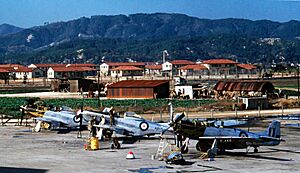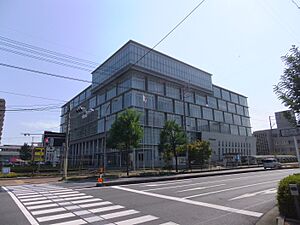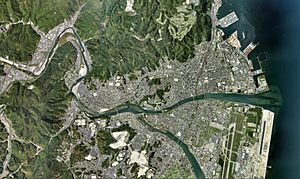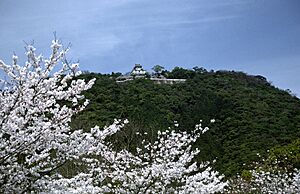Iwakuni facts for kids
Quick facts for kids
Iwakuni
岩国市
|
|||||||||||
|---|---|---|---|---|---|---|---|---|---|---|---|

Iwakuni, including the Kintai Bridge
|
|||||||||||
|
|||||||||||
 |
|||||||||||
| Country | Japan | ||||||||||
| Region | Chūgoku (San'yō) | ||||||||||
| Prefecture | Yamaguchi | ||||||||||
| Area | |||||||||||
| • Total | 873.72 km2 (337.35 sq mi) | ||||||||||
| Population
(June 1, 2023)
|
|||||||||||
| • Total | 127,512 | ||||||||||
| • Density | 156.95/km2 (406.5/sq mi) | ||||||||||
| Time zone | UTC+09:00 (JST) | ||||||||||
| City hall address | 1-14-51 Imazumachi, Iwakuni-shi, Yamaguchi-ken 740-8585 | ||||||||||
| Climate | Cfa | ||||||||||
|
|||||||||||
Iwakuni (Iwakuni (岩国市, Iwakuni-shi)) is a cool city located in Yamaguchi Prefecture, Japan. As of June 2023, about 127,512 people live here. The city covers a total area of about 873.72 square kilometers.
Contents
- Geography of Iwakuni
- History of Iwakuni
- Iwakuni's Economy
- Education in Iwakuni
- Transportation in Iwakuni
- Media in Iwakuni
- Sports in Iwakuni
- Sister City Connections
- Fun Places to Visit in Iwakuni
- Delicious Food in Iwakuni
- Military Aviation in Iwakuni
- Famous People from Iwakuni
- Images for kids
- See also
Geography of Iwakuni
Iwakuni is in the southeast part of Yamaguchi Prefecture. It shares a border with Hiroshima Prefecture to the east. To the south, it meets the Seto Inland Sea. The Nishiki River flows right through the middle of the city.
Nearby Cities and Towns
Iwakuni is surrounded by several other places.
- In Hiroshima Prefecture:
- Hatsukaichi
- Ōtake
- In Shimane Prefecture:
- Masuda
- Yoshika
- In Yamaguchi Prefecture:
- Hikari
- Shūnan
- Tabusei
- Waki
- Yanai
Iwakuni's Climate
Iwakuni has a humid subtropical climate. This means it has hot summers and cool winters. It rains a lot throughout the year. The rainiest months are from March to October. This includes the monsoon season in June and July. There are also typhoons in September.
The average yearly temperature in Iwakuni is about 15.1°C. The city gets about 1781.4 mm of rain each year. July is usually the wettest month. August is the hottest month, with temperatures around 26.9°C. January is the coldest, at about 4.2°C. The hottest temperature ever recorded was 39.0°C in August 2024. The coldest was -12.9°C in February 1977.
| Climate data for Iwakuni (1991−2020 normals, extremes 1977−present) | |||||||||||||
|---|---|---|---|---|---|---|---|---|---|---|---|---|---|
| Month | Jan | Feb | Mar | Apr | May | Jun | Jul | Aug | Sep | Oct | Nov | Dec | Year |
| Record high °C (°F) | 18.6 (65.5) |
21.4 (70.5) |
24.5 (76.1) |
29.7 (85.5) |
32.8 (91.0) |
34.4 (93.9) |
37.2 (99.0) |
37.8 (100.0) |
36.1 (97.0) |
32.4 (90.3) |
25.8 (78.4) |
21.3 (70.3) |
37.8 (100.0) |
| Mean daily maximum °C (°F) | 9.0 (48.2) |
9.9 (49.8) |
13.5 (56.3) |
19.0 (66.2) |
23.7 (74.7) |
26.4 (79.5) |
30.5 (86.9) |
31.9 (89.4) |
28.1 (82.6) |
22.6 (72.7) |
16.8 (62.2) |
11.4 (52.5) |
20.2 (68.4) |
| Daily mean °C (°F) | 4.2 (39.6) |
4.9 (40.8) |
8.2 (46.8) |
13.4 (56.1) |
18.1 (64.6) |
21.8 (71.2) |
25.9 (78.6) |
26.9 (80.4) |
23.1 (73.6) |
17.3 (63.1) |
11.4 (52.5) |
6.3 (43.3) |
15.1 (59.2) |
| Mean daily minimum °C (°F) | 0.1 (32.2) |
0.5 (32.9) |
3.1 (37.6) |
8.0 (46.4) |
12.9 (55.2) |
17.9 (64.2) |
22.3 (72.1) |
23.0 (73.4) |
19.0 (66.2) |
12.7 (54.9) |
6.9 (44.4) |
2.1 (35.8) |
10.7 (51.3) |
| Record low °C (°F) | −7.1 (19.2) |
−8.3 (17.1) |
−5.0 (23.0) |
−1.1 (30.0) |
3.4 (38.1) |
9.3 (48.7) |
14.8 (58.6) |
15.8 (60.4) |
7.5 (45.5) |
2.0 (35.6) |
−1.1 (30.0) |
−5.2 (22.6) |
−8.3 (17.1) |
| Average precipitation mm (inches) | 54.3 (2.14) |
79.9 (3.15) |
145.6 (5.73) |
172.8 (6.80) |
187.5 (7.38) |
274.1 (10.79) |
292.1 (11.50) |
154.9 (6.10) |
182.4 (7.18) |
113.7 (4.48) |
77.5 (3.05) |
62.5 (2.46) |
1,781.4 (70.13) |
| Average precipitation days (≥ 1.0 mm) | 6.2 | 7.3 | 9.7 | 9.3 | 9.4 | 11.8 | 11.0 | 8.5 | 8.9 | 6.8 | 6.4 | 6.4 | 101.7 |
| Mean monthly sunshine hours | 153.7 | 150.3 | 181.3 | 204.4 | 220.8 | 151.8 | 176.2 | 217.8 | 167.0 | 179.8 | 159.4 | 156.5 | 2,127.2 |
| Source: Japan Meteorological Agency | |||||||||||||
| Climate data for Kuga, Iwakuni (1991−2020 normals, extremes 1977−present) | |||||||||||||
|---|---|---|---|---|---|---|---|---|---|---|---|---|---|
| Month | Jan | Feb | Mar | Apr | May | Jun | Jul | Aug | Sep | Oct | Nov | Dec | Year |
| Record high °C (°F) | 18.8 (65.8) |
21.8 (71.2) |
23.7 (74.7) |
29.2 (84.6) |
32.4 (90.3) |
34.1 (93.4) |
38.1 (100.6) |
38.1 (100.6) |
36.2 (97.2) |
31.3 (88.3) |
26.8 (80.2) |
20.5 (68.9) |
38.1 (100.6) |
| Mean daily maximum °C (°F) | 9.3 (48.7) |
10.5 (50.9) |
14.2 (57.6) |
19.8 (67.6) |
24.5 (76.1) |
27.0 (80.6) |
30.8 (87.4) |
32.2 (90.0) |
28.5 (83.3) |
23.1 (73.6) |
17.2 (63.0) |
11.6 (52.9) |
20.7 (69.3) |
| Daily mean °C (°F) | 3.6 (38.5) |
4.6 (40.3) |
8.1 (46.6) |
13.3 (55.9) |
18.1 (64.6) |
21.9 (71.4) |
25.8 (78.4) |
26.8 (80.2) |
23.1 (73.6) |
17.1 (62.8) |
11.0 (51.8) |
5.6 (42.1) |
14.9 (58.9) |
| Mean daily minimum °C (°F) | −1.2 (29.8) |
−0.6 (30.9) |
2.3 (36.1) |
7.1 (44.8) |
12.3 (54.1) |
17.7 (63.9) |
22.1 (71.8) |
22.8 (73.0) |
18.8 (65.8) |
12.1 (53.8) |
5.7 (42.3) |
0.6 (33.1) |
10.0 (49.9) |
| Record low °C (°F) | −8.9 (16.0) |
−11.5 (11.3) |
−6.4 (20.5) |
−3.0 (26.6) |
1.7 (35.1) |
7.9 (46.2) |
14.6 (58.3) |
15.5 (59.9) |
7.2 (45.0) |
0.0 (32.0) |
−2.6 (27.3) |
−7.2 (19.0) |
−11.5 (11.3) |
| Average precipitation mm (inches) | 62.0 (2.44) |
90.7 (3.57) |
158.9 (6.26) |
186.8 (7.35) |
211.0 (8.31) |
292.2 (11.50) |
333.6 (13.13) |
166.4 (6.55) |
183.6 (7.23) |
110.3 (4.34) |
82.9 (3.26) |
66.0 (2.60) |
1,944.3 (76.55) |
| Average precipitation days (≥ 1.0 mm) | 6.6 | 8.0 | 10.0 | 9.8 | 9.4 | 12.0 | 11.3 | 8.9 | 9.1 | 6.6 | 7.1 | 6.7 | 105.5 |
| Mean monthly sunshine hours | 147.0 | 144.0 | 176.6 | 190.9 | 201.6 | 139.4 | 156.7 | 194.7 | 162.9 | 178.1 | 154.9 | 149.0 | 1,989.1 |
| Source: Japan Meteorological Agency | |||||||||||||
| Climate data for Hirose, Iwakuni (1991−2020 normals, extremes 1976−present) | |||||||||||||
|---|---|---|---|---|---|---|---|---|---|---|---|---|---|
| Month | Jan | Feb | Mar | Apr | May | Jun | Jul | Aug | Sep | Oct | Nov | Dec | Year |
| Record high °C (°F) | 17.6 (63.7) |
21.4 (70.5) |
27.1 (80.8) |
30.3 (86.5) |
34.4 (93.9) |
34.4 (93.9) |
38.3 (100.9) |
39.0 (102.2) |
36.8 (98.2) |
32.0 (89.6) |
29.1 (84.4) |
20.5 (68.9) |
39.0 (102.2) |
| Mean daily maximum °C (°F) | 8.4 (47.1) |
9.9 (49.8) |
14.0 (57.2) |
19.8 (67.6) |
24.6 (76.3) |
27.1 (80.8) |
30.7 (87.3) |
32.1 (89.8) |
28.1 (82.6) |
22.6 (72.7) |
16.6 (61.9) |
10.7 (51.3) |
20.4 (68.7) |
| Daily mean °C (°F) | 2.8 (37.0) |
3.8 (38.8) |
7.3 (45.1) |
12.7 (54.9) |
17.5 (63.5) |
21.4 (70.5) |
25.3 (77.5) |
26.1 (79.0) |
22.1 (71.8) |
16.0 (60.8) |
10.0 (50.0) |
4.8 (40.6) |
14.2 (57.5) |
| Mean daily minimum °C (°F) | −1.0 (30.2) |
−0.7 (30.7) |
2.0 (35.6) |
6.6 (43.9) |
11.6 (52.9) |
17.0 (62.6) |
21.5 (70.7) |
22.1 (71.8) |
18.0 (64.4) |
11.5 (52.7) |
5.6 (42.1) |
1.0 (33.8) |
9.6 (49.3) |
| Record low °C (°F) | −10.3 (13.5) |
−12.9 (8.8) |
−6.3 (20.7) |
−3.0 (26.6) |
0.1 (32.2) |
5.4 (41.7) |
12.9 (55.2) |
13.7 (56.7) |
4.9 (40.8) |
0.2 (32.4) |
−2.8 (27.0) |
−8.4 (16.9) |
−12.9 (8.8) |
| Average precipitation mm (inches) | 85.8 (3.38) |
108.1 (4.26) |
181.9 (7.16) |
210.6 (8.29) |
246.8 (9.72) |
311.3 (12.26) |
370.3 (14.58) |
207.7 (8.18) |
213.4 (8.40) |
126.7 (4.99) |
97.0 (3.82) |
89.9 (3.54) |
2,263.4 (89.11) |
| Average precipitation days (≥ 1.0 mm) | 10.6 | 10.9 | 11.7 | 10.2 | 9.4 | 12.6 | 12.6 | 10.7 | 10.1 | 7.2 | 8.3 | 10.5 | 124.8 |
| Mean monthly sunshine hours | 106.9 | 119.9 | 162.7 | 182.7 | 207.5 | 144.7 | 146.0 | 180.0 | 151.3 | 165.1 | 129.0 | 106.3 | 1,802 |
| Source: Japan Meteorological Agency | |||||||||||||
Population Changes Over Time
The population of Iwakuni has changed quite a bit over the years. In 1950, there were almost 150,000 people. The population grew for a while, reaching its highest in 1960 with over 165,000 people. Since then, the number of people living in Iwakuni has slowly decreased. By 2020, the population was about 129,125.
| Historical population | ||
|---|---|---|
| Year | Pop. | ±% |
| 1950 | 149,965 | — |
| 1955 | 162,518 | +8.4% |
| 1960 | 165,498 | +1.8% |
| 1965 | 162,015 | −2.1% |
| 1970 | 157,338 | −2.9% |
| 1975 | 161,103 | +2.4% |
| 1980 | 163,692 | +1.6% |
| 1985 | 161,682 | −1.2% |
| 1990 | 158,293 | −2.1% |
| 1995 | 156,347 | −1.2% |
| 2000 | 153,985 | −1.5% |
| 2005 | 149,702 | −2.8% |
| 2010 | 143,888 | −3.9% |
| 2015 | 136,757 | −5.0% |
| 2020 | 129,125 | −5.6% |
| Iwakuni population statistics | ||
History of Iwakuni
The area where Iwakuni is today was once part of an old province called Suō Province. During the Sengoku period, which was a time of civil war in Japan, the Mōri clan controlled this land. After a big battle in 1600, a warlord named Kikkawa Hiroie was given the Iwakuni area. He helped the Mōri family avoid losing everything.
The Kikkawa clan built Iwakuni Castle. The city of Iwakuni grew up around this castle. For a long time, Iwakuni was like a small, independent part of a larger domain called Chōshū Domain. This lasted until the Meiji restoration, a big change in Japan's government.
The town of Iwakuni officially started on April 1, 1889. It became a full city on April 1, 1940. Later, in 2006, Iwakuni grew even bigger. It joined with several nearby towns and a village. These included Kuga, Mikawa, Miwa, Nishiki, Shūtō, Yū, and Hongō.
Iwakuni's Economy
Iwakuni is an important part of the Seto Inland Sea's industrial area. One of the main industries here is petroleum. Nippon Oil has a large refinery in Marifu. It produces a lot of oil every day.
Another important industry is pulp production. Nippon Paper's Iwakuni mill makes pulp using a special process. This process uses very little energy. Other big industries include making fibers, spinning textiles, and producing petrochemicals and paper.
Farming is also important. The main farm product is renkon, which is lotus root. It is grown in the Hasuda field, near Minami Iwakuni station.
Education in Iwakuni
Iwakuni has many schools for kids of all ages. The city government runs 35 public elementary schools. It also has 15 public junior high schools. There is even one school that combines elementary and junior high levels.
The Yamaguchi Prefectural Board of Education runs one junior high school and five public high schools. There are also private schools, including one junior high and three high schools. A special education school for students with disabilities is also available. For older students, there is the private Iwakuni Junior College.
One famous person who went to high school in Iwakuni is Shinji Mori. He was a professional baseball player. He played for the Tampa Bay Rays in 2005.
Transportation in Iwakuni
Getting around Iwakuni is easy with different types of transportation.
Airport
Iwakuni has the Marine Corps Air Station Iwakuni. This is mainly a military airport. However, a civilian passenger terminal was built in 2012. Now, there are daily commercial flights to Tokyo.
Railway Stations
You can travel by train in Iwakuni.
- JR West – San'yō Shinkansen (bullet train)
- Shin-Iwakuni
- JR West – San'yō Main Line
- Iwakuni - Minami-Iwakuni - Fujū - Tsuzu - Yū - Kōjiro
- JR West – Gantoku Line
- Iwakuni - Nishi-Iwakuni - Kawanishi - Hashirano - Kimmeiji - Kuga - Suō-Takamori - Yonekawa
- Nishikigawa Railway – Seiryū Line
- Iwakuni - Nishi-Iwakuni - Kawanishi - Seiryū-Shin-Iwakuni - Shuuchi-Kasagami - Minami-Gōchi - Yukaba - Kita-Gōchi - Mukuno - Naguwa - Seiryu Miharashi - Nekasa - Kawayama - Yanaze - Nishikichō
Major Highways
Several important highways pass through or near Iwakuni.
- San'yō Expressway
- Chugoku Expressway
- Route 2
- Route 187
- Route 188
- Route 189
- Route 376
- Route 434
- Route 437
Media in Iwakuni
Iwakuni has different ways for people to get news and entertainment.
Newspapers
- Stars and Stripes (This newspaper is for people on the military base.)
- Yamaguchi Shimbun
Television Stations
You can watch several TV channels in Iwakuni.
- YAB TV (part of ANN)
- KRY TV (part of NNN)
- TYS TV (part of JNN)
- NHK TV
Sports in Iwakuni
Iwakuni is a place where professional baseball players train. The minor league team for the Hiroshima Toyo Carp is based here. Their baseball field, Yuu Baseball Ground, is about 20 kilometers southwest of central Iwakuni. It's located in the Yū area.
Sister City Connections
Iwakuni has special friendships with cities around the world. These are called sister city relationships.
 Everett, Washington, United States
Everett, Washington, United States Jundiaí, Brazil
Jundiaí, Brazil Taicang, China
Taicang, China Tottori
Tottori
Fun Places to Visit in Iwakuni
Many tourists who visit nearby Hiroshima and Miyajima also come to see Iwakuni. It has some amazing sights!
The Famous Kintai Bridge
The Kintai Bridge (Kintai-kyō) is the most popular place to visit in Iwakuni. This beautiful bridge crosses the Nishiki River. It was first built in 1673. A powerful typhoon destroyed it in 1950. But people rebuilt it using the same old techniques. The new bridge was finished in 1953. It has five unique arches that are a symbol of western Honshū. The Kintai Bridge has been renovated several times, most recently in 2004. You can get to the bridge by bus from Iwakuni Station or Shin-Iwakuni Station.
Kikko Park: History and Nature
Kikko Park is right across the Kintai Bridge. This area used to be where the Kikkawa family, who built the castle, lived. The park has a large fountain and many shops. You can also see lots of different flowers here.
Kikko Park is also home to a special place for white snakes. These rare snakes are only found in Iwakuni. The Japanese government has named them special national treasures. White snakes are a symbol of Benten, the Japanese goddess of wealth. Many people believe finding a white snake brings good luck.
Imazu White Snake Museum
In Japanese stories, a white snake in your home means good fortune. The white snakes in Iwakuni are a special kind of albino Japanese Rat Snake. They are gentle, with ivory white scales and ruby-red eyes. You can see them up close at a viewing center near Kikko Park.
Iwakuni Castle: A Glimpse into the Past
Iwakuni Castle lets you see what old Japan was like. The castle was first built in 1608. But it was destroyed just seven years later. It was rebuilt in 1962. Iwakuni Castle sits on top of Mount Shiroyama. You can walk up or take a cable car. Inside the castle, there's a museum with old armor, weapons, and items from the Kikkawa family. From the top, you get an amazing view of Iwakuni. The castle area also has trails for hiking.
Cormorant Fishing on the River
In the summer, you can watch traditional cormorant fishing on the Nishiki River. Fishermen wear special old clothes. They use trained cormorants to catch fish. This fishing method is over 300 years old! The fishermen control the birds and then take the fish from their mouths. In early spring, the cherry blossoms along the Nishiki River are also a beautiful sight.
More Historical Places
- The Mekata Residence was the home of a samurai family from the 1700s. It's one of the few left and is considered a national treasure.
- The Momijidani Maple Park used to be a temple garden. Many people visit in autumn to see the colorful maple leaves.
- The Nagayamon Gate of the Kagawa Family Residence is another old samurai home that is well-preserved. It's considered a cultural treasure for the prefecture.
- The Iwakuni Art Museum has old pottery, armor, furniture, and other items once used by powerful lords.
Iwakuni also has many beautiful plants and trees. Besides the cherry and maple trees along the Nishiki River, you can see Japanese apricot trees, peony bushes, azaleas, Japanese irises, and hydrangeas. Many of these are around Kikko Park.
Fun Festivals in Iwakuni
- The Kintai Bridge Festival happens every year on April 29 at Kikko Park. A highlight is the "Sankin-koutai" parade. Locals dress up in old samurai costumes and march across the bridge.
- The Nishiki River Water Festival is on the first Saturday of August. There's a big fireworks show. Many people come dressed in traditional clothes like kimonos.
Delicious Food in Iwakuni
When you visit Iwakuni, you should try some of its special local foods!
Iwakuni Sushi
Iwakuni is famous for its unique sushi. It's made in a square mold. What's cool is that it's prepared in huge amounts. Usually, there's enough to feed about 150 people at once! You can also find many "sushi-go-rounds" where sushi travels around the restaurant on a moving belt.
Fresh Lotus Roots
Iwakuni is known for its fresh lotus roots. Many people love them! Lotus roots grown in Iwakuni usually have nine holes. Lotus roots from other places often have eight holes. These roots are cooked in different ways, like stir-fried, simmered, or deep-fried.
Chagayu (Tea Porridge)
Iwakuni Chagayu is a rice porridge flavored with tea. It was first made about 400 years ago. A leader named Hiroie Kikkawa created it to feed his soldiers cheaply. The tea used was called "bancha." Even though it's a simple dish, it has a long history in Iwakuni.
Ohira Dish
Ohira is a dish made with simmered vegetables. It also includes wild plants and chicken.
Other Special Products
- Ishi ningyo are handmade stone dolls. They are made from the nests of an insect found in Iwakuni's rivers. People say these dolls hold the spirits of those who died building the Kintai Bridge. They are popular souvenirs.
- Kikkougama Iwakuni-yaki is a type of ceramic pottery. It was used about 300 years ago during the time of the Iwakuni han (domain). It's still made today and is known for its elegant look and warm feel.
Military Aviation in Iwakuni

Iwakuni has had a military airfield since the 1930s. The Japanese government bought the land in 1938 to build a naval air station. It officially opened in 1940. During World War II, it was used for training and defense. It had many trainer planes and Zero fighter planes.
After the war, military forces from Australia used the base. Then, in 1952, it became an air station for the United States Marine Corps. Today, Marine Corps Air Station (MCAS) Iwakuni is also shared with the Japanese Maritime Self Defense Force.
MCAS Iwakuni is the only U.S. Marine Corps base on Honshu, which is Japan's main island. It is home to about half of the 1st Marine Aircraft Wing. It also has parts of the 3rd Marine Logistics Group. Plus, Fleet Air Wing 31 of the Japan Maritime Self Defense Force is there. In 2017, about 15,000 U.S. military and Japanese defense workers were at the base.
In 2014, there were plans to move the U.S. Carrier Air Wing from another base to Iwakuni. This would make the base even bigger. In August 2017, the U.S. Navy announced that the first jet squadrons would move to MCAS Iwakuni. This group is called Carrier Air Wing (CVW) 5. It is the only U.S. Navy carrier strike group deployed forward.
Famous People from Iwakuni
- Matthew Heafy, the lead singer of the band Trivium, was born here in 1986.
- Hideo Hiraoka, a politician.
- Kenshi Hirokane, a manga artist.
- Takeo Kurusu, a politician.
- Keiichi Nanba, a voice actor.
- Arisaka Nariakira, a general and the inventor of the Arisaka Rifle.
- Ryūtarō Ōtomo, an actor.
- Masato Sako, an actor.
- Naoto Tajima, who won a gold medal in the triple jump at the 1936 Summer Olympics in Berlin. He also won a bronze medal in the long jump.
- Hasegawa Yoshimichi, a general in the Imperial Japanese Army.
Images for kids
See also
 In Spanish: Iwakuni para niños
In Spanish: Iwakuni para niños










